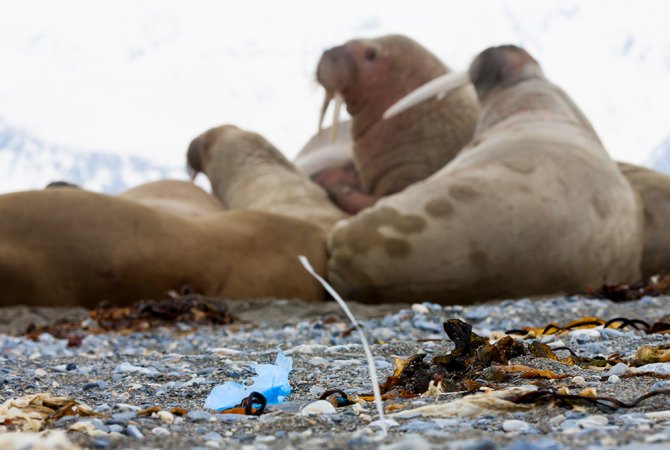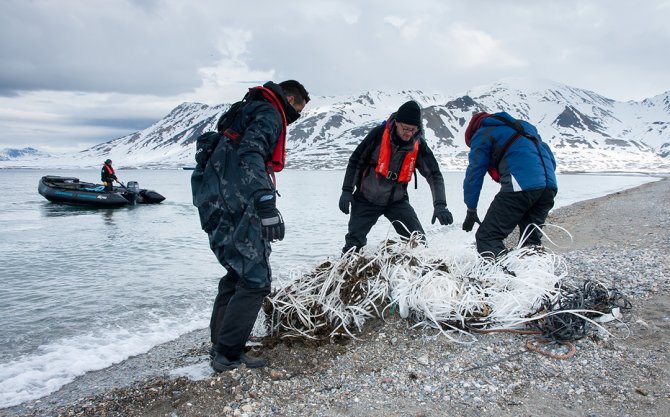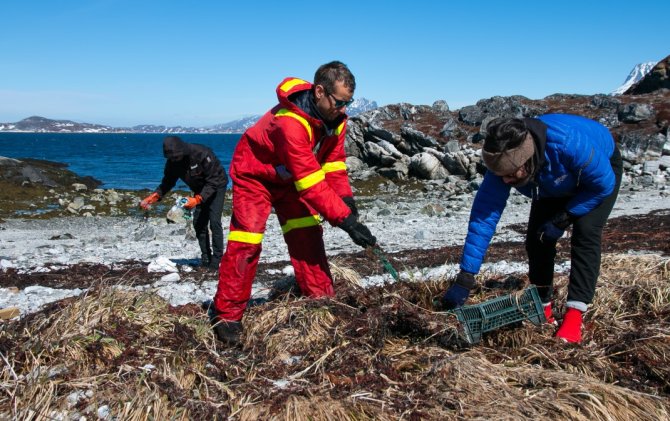The Arctic Marine Litter Project: knowing the sources to work on solutions
Take a moment to visualise the Arctic: icebergs, snow-capped mountains, polar bears, walruses...But the truth is quite the opposite. Many of the beaches in the European Arctic are littered, and the most abundant type of litter is plastic.
A never ending stream of plastics
Although lying at the outer edge of Europe, the Arctic is not isolated and certainly not unaffected by human influence. Through ocean currents, plastic litter is transported to the Arctic every day. And it stays there, often locked in the ice. In a way, one could say that the Arctic is the drainage hole for plastics coming from Europe and North America.
We know that litter travels long distances with ocean currents, but this is the first time that litter found at the remote Arctic island of Jan Mayen has been traced back to its origin, Canada
A threat to wildlife and local communities
This continuous stream of plastics coming into the Arctic not only poses a threat to wildlife but also local communities and tourists who are unwittingly exposed to this waste. Animals of all sizes, from zooplankton to polar bears can be affected by ingesting plastics or getting entangled in nets and ropes. These same items also pose a safety risk to shipping in the area due to the risk of entanglement in ship propellers.

Prevention is the solution
What can be done to solve this problem? Cleaning up beaches or collecting floating plastic from the Arctic sea could be an option but also an immense task, given that millions of tons of plastic items are stuck in the ice, on unreachable beaches or on the seafloor. We believe in prevention. Our mission is to find the origin, causes and solutions to plastic pollution of the Arctic.

The Arctic Marine Litter Project
Since it began in 2017, the Arctic Marine Litter Project has been working towards proposing solutions based on factual findings. Our long-term vision is to end marine littering in the North-Atlantic Arctic and thus protect biodiversity in this fragile region. Our ultimate goal is to influence a change in human behaviour regarding the discard of marine litter. By actively involving local stakeholders and experts in this endeavour, a feeling of ownership and a better understanding of the issue and the solutions can be cultivated and possible solutions and policy changes can be initiated.
In each region of the North-Atlantic Arctic, we take a cyclical approach, where we engage local stakeholders and experts in:
- Identifying the type, source, origin and the threat to biodiversity of beach litter items
- Linking the major item categories to actors, determine the underlying causes and potential solutions
- Providing knowledge to support stakeholders in taking action

The project is a collaborative, multidisciplinary project and involves partners throughout the Arctic.
In the Arctic Marine Litter Project we focus on gathering information in more detail than has previously been available. To realise this, an essential element in the project is the interactive multi-day Litter-ID session. In this, our work is much like detectives, doing a kind of CSI-Plastics, where we thoroughly analyse collected beach litter together with local experts and stakeholders. The aim of these sessions is to identify the sources, causes, threats to biodiversity of beach litter as well as potential solutions. We aim to provide such information for the entire North-Atlantic Arctic region by 2022.
Since the start of the project we have already focused our efforts on Svalbard, Jan Mayen, Iceland and Greenland. Our ambition is to expand our activities to the North-Atlantic Arctic regions of Canada and Russia.
So far we found that a large proportion of litter in the Arctic is fisheries related. Fishing nets are an obvious part of this, but our investigations have shown that many other types of litter also originate from fishing activities. During Litter-ID sessions we therefore put extra effort in identifying the sources, underlying causes and solutions to fisheries related litter by involving experts and stakeholders from the industry.

We need you to tackle this problem
As the problem of plastics in the Arctic is multi-faceted and international, there is no single solution. Therefore, working on solutions means working on a variety of issues, with a variety of stakeholders and scientific disciplines.
Together with partners throughout the Arctic, Wageningen University & Research provides the expertise needed to work on effective solutions and to preserve this magnificent landscape for future generations.
Funding and donations
The Arctic Marine Litter Project is part of Wageningen University & Research’s Fundamental Change campaign. The campaign highlights fifteen research projects that showcase the many different ways in which WUR contributes to the SDG’s. Private individuals, governments, companies and foundations are invited to support these projects with a charitable donation. Donor funding for the project has so far kindly been granted by the Government of the Netherlands, WWF Denmark, the Circumpolar Conservation Union and the Dolfinarium. Project funding has also been received from the Svalbard Environmental Fund and Wageningen University & Research.
Are you interested in contributing to the Arctic Marine Litter project and help us in finding solutions, please contact Wouter Jan Strietman. We will be happy to provide you with more information and the options to support the project.
Blogs
News about Arctic litter
This research in the media
- The Guardian: Plastic polluted Arctic islands are dumping ground for Gulf Stream
- Resource: Spitsbergen is the waste pit of the ocean
- Express: The Arctic wilderness blighted by the plastic debris of modern life
- DailyMail: What this toy from a 1958 packet of Sugar Puffs tells us about the catastrophe caused by plastic
